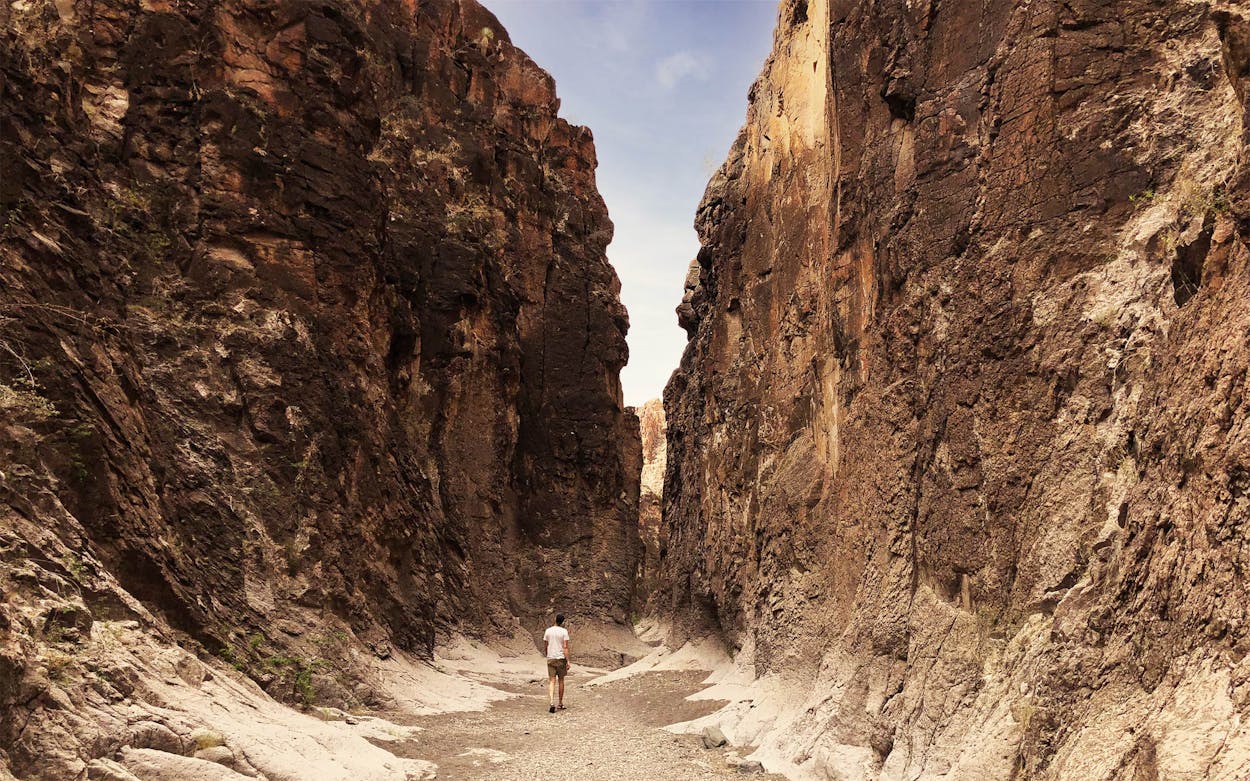A San Antonio man struck out last June to hike into Closed Canyon, a slot canyon at Big Bend Ranch State Park that leads to a steep pour-off above the Rio Grande. The gray cliffs along the two-mile out-and-back trail narrowed as he walked, alone, eventually reaching a fifteen-foot drop. Most hikers turn around at that point, but the 45-year-old man jumped down the ledge, quickly realizing he couldn’t climb back up the slick rock. He kept going down the canyon, eventually reaching a forty-foot pour-off, where he jumped again, breaking his leg as he crash-landed.
Emergency crews, alerted by the car he’d left parked overnight in the day-use lot at the trailhead, found the injured and exhausted man late the next evening. It took thirteen crew members four hours using high-angle rescue gear to get him up the cliff and back to the trailhead on FM 170, where an ambulance waited. After being treated for dehydration and the broken leg, he made a full recovery.
“He admitted to us openly that he panicked,” says Nathanael Gold, superintendent of Big Bend Ranch State Park. “He knew he should have stayed put at the first pour-off, but he went all the way to the river.”
The mishap was just one of a spate in rescues at the enormous, lightly staffed state park since the pandemic began. (It wasn’t the first serious incident in Closed Canyon, however: a 65-year-old man died there from a fall in 2018.) The area is grappling with an influx of visitors, some of whom are unprepared for the remote park’s rugged conditions. “Folks are driving down here expecting what they’re used to in the rest of the Texas state parks system,” Gold says.
Big Bend Ranch is far from typical. The biggest state park in Texas, it deserves its nickname, the Other Side of Nowhere. Most tourists in West Texas skip Big Bend Ranch in favor of the national park eighty miles to the east, which has more amenities, including a restaurant and five visitor centers. The state park is more desolate, with 300,000 prickly, sun-scorched acres sculpted by geologic uplifts and volcanoes. Both parks have numerous hazards, from snakes to intense heat and rocky mesas and canyons. “[Big Bend Ranch] is rugged, it’s wild, and it’s built so people can experience wilderness and solitude,” Gold says.
During the pandemic, a record number of them have come seeking just that. In 2015, the state park had roughly 23,000 visitors. In 2020, despite a two-week shutdown because of COVID-19 in April and limited capacity since then, more than 53,000 people stopped by. In September, October, and November, the park saw almost 21,000 visitors—nearly twice as many as over the same period in 2019.
Gold says the boost in visitation is partly because more people are aware of the park, which fully opened to the public for the first time in 2009, but it’s also because cooped-up families are eager to get away during the pandemic. With less-experienced visitors making the trip, the number of search and rescues has grown. Park staff logged 23 rescues in 2020, more than double the 11 recorded in 2019. The majority of incidents were heat-related, Gold says.
At least two other parks are seeing similar trends. At Enchanted Rock State Natural Area, search-and-rescue incidents have increased by 49 percent, from 47 in 2019 to 70 last year. That’s despite a slight decrease in the park’s capacity because of the pandemic. Most of those emergencies were a result of visitors who got lost or were unprepared for conditions at the 1,640-acre, mostly undeveloped property, said superintendent Doug Cochran.
At Franklin Mountains State Park in El Paso, a mountainous, 26,600-acre mecca for hiking, camping, climbing, biking, and paragliding, park officials noticed a rash of rescues on a particularly steep four-mile stretch of the Ron Coleman Trail. When four incidents occurred there in one week early last spring, each requiring manpower and resources, staff temporarily closed the trail. (They plan to eventually reroute and reopen it.)
“People were hiking off trail, and slipping and falling,” said superintendent Cesar Mendez.
Government Canyon State Natural Area, a 12,244-acre park in far west San Antonio popular with cyclists, campers, and hikers who want to check out the dinosaur tracks, cut back on capacity when COVID-19 struck. Even with a full closure for part of April, it saw 4,000 more visitors in 2020 than in 2019, when 72,300 came through the gates.
“It was a phenomenon we weren’t expecting—even though we had less availability, we were filling up that availability,” said superintendent Nic Maloukis, who notes that the park is only open Friday through Monday. “The population is clambering for green space.”
Unlike Big Bend Ranch, though, Government Canyon has seen a drop in the number of search and rescues. In 2019, staff made fourteen wilderness rescues, most of them heat emergencies. In 2020, they made only eight.
Maloukis credits the park’s new trail adviser program, in which trained volunteers hang out at trailheads to remind visitors to carry water and make sure they’re prepared. “The terrain and elevation gain here are unlike other areas in town,” Maloukis says. “People come out who say, ‘I hike five miles a day, no problem,’ but they’re talking about the city’s greenbelt.”
It’s a reminder that visitors should know what they’re getting into before they head out. Be sure to check weather conditions and read maps and reviews for the trail. Carry plenty of water—at least one gallon per person per day—wear proper shoes, and let someone know where you’re going and what time you expect to return.
“We exist to serve people,” said Gold, from Big Bend Ranch. “But what we ask of folks is please do the research, ask questions, and almost overprepare.”
- More About:
- Fredericksburg
- El Paso
- Big Bend






